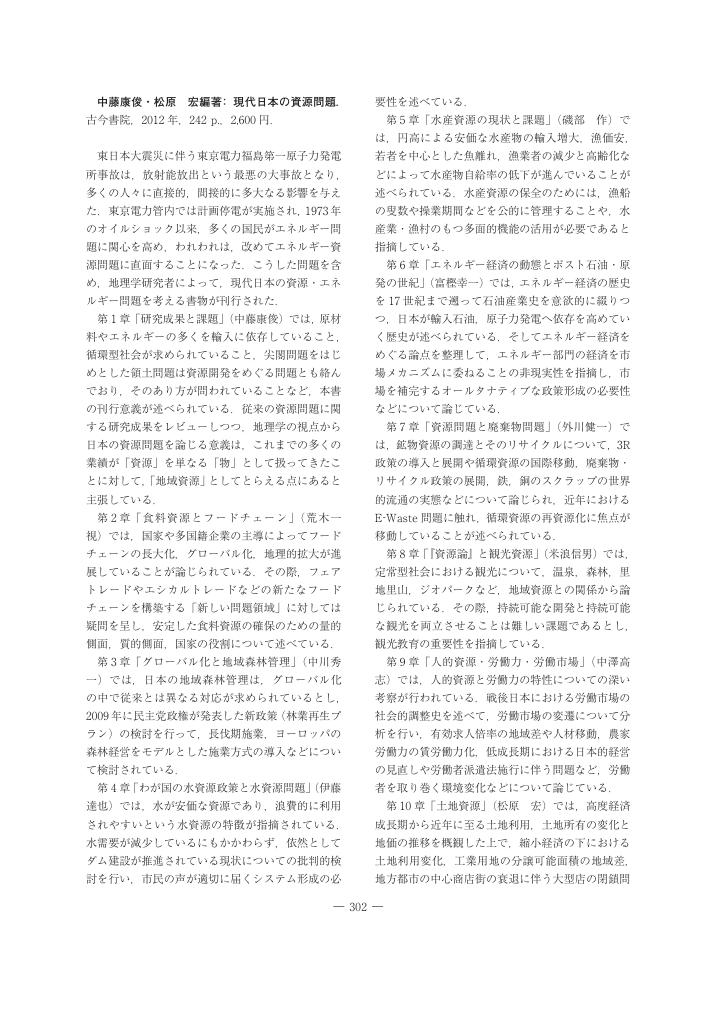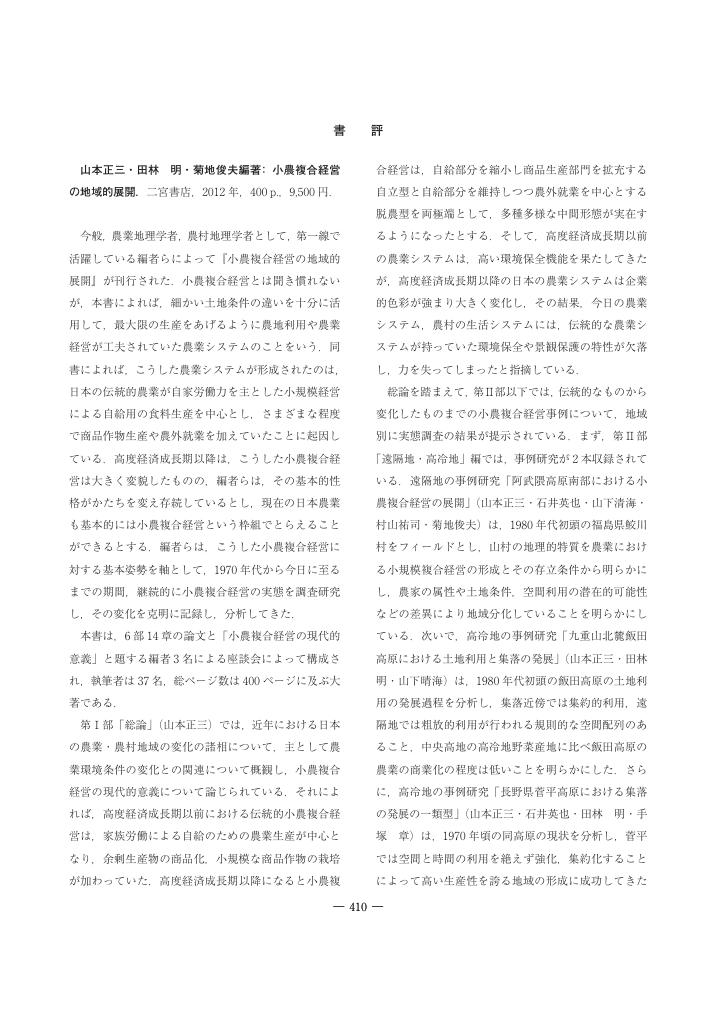13 0 0 0 OA 信越本線北高崎・群馬八幡間への新駅開設可能性調査報告
- 著者
- 米本 清 西野 寿章
- 出版者
- 高崎経済大学地域科学研究所
- 雑誌
- 産業研究 = Bulletin of the Institute of Regional Science (ISSN:09155996)
- 巻号頁・発行日
- vol.52, no.1, pp.35-55, 2016-11-15
6 0 0 0 OA 東京の電気事業と電源開発
- 著者
- 西野 寿章
- 出版者
- 公益社団法人 東京地学協会
- 雑誌
- 地学雑誌 (ISSN:0022135X)
- 巻号頁・発行日
- vol.123, no.2, pp.298-314, 2014-04-25 (Released:2014-05-16)
- 参考文献数
- 46
- 被引用文献数
- 3
The purpose of this paper is to clarify the history and the characteristics of electric utility companies in Tokyo. In 1887, the first electricity supply company in Japan was established in Tokyo. In 1933, there were 818 electric utility companies. Before World War II, two or more electricity supply companies supplied one region, and there was tough competition to supply electricity to the Tokyo area. In 1938, the principle of free competition was replaced by nationwide management by the pre-war military government. Tokyo Electric Power Company was established in Tokyo by the Potsdam government ordinance in 1951, and the right to supply electricity to a region was limited to one company. Disproportionate electricity demand and amount of power generated is a historical characteristic of electric utility companies operating in Tokyo. The rate of self-sufficiency of electricity in Tokyo was 15 percent in 1931, and it was three percent in January 2012. The power generation and electric supply system began to be discussed after the nuclear plant disaster caused by a major earthquake on March 11, 2011 at Fukushima. In August 2011, the Tokyo Metropolitan Government Office began to examine constructing a large-scale power plant fueled by natural gas.As the population of Japan decreases, revenues will decline. Before World War II, Tokyo City's managed electric utility obtained high earnings constantly. These high earnings were a very important and stable source of income for the local government. The system of the electric utility companies in Japan before World War II could provide a model for a reorganized electricity supply system in the future.
4 0 0 0 OA 戦後の岩手県における山村地域の電化過程についての覚え書き
- 著者
- 西野 寿章 Toshiaki Nishino 高崎経済大学地域政策学部
- 雑誌
- 地域政策研究 = STUDIES OF REGIONAL POLICY (ISSN:13443666)
- 巻号頁・発行日
- vol.19, no.4, pp.189-207, 2017-03-31
2 0 0 0 OA 筒井一伸編:田園回帰がひらく新しい都市農山村関係
- 著者
- 西野 寿章
- 出版者
- 公益社団法人 日本地理学会
- 雑誌
- 地理学評論 Series A (ISSN:18834388)
- 巻号頁・発行日
- vol.94, no.4, pp.271-272, 2021-07-01 (Released:2023-02-19)
2 0 0 0 OA 長野堰の成立時期に関する一考察
- 著者
- 西野 寿章 鈴木 耕太郎
- 出版者
- 高崎経済大学地域科学研究所
- 雑誌
- 産業研究 = Bulletin of the Institute of Regional Science (ISSN:09155996)
- 巻号頁・発行日
- vol.56, no.1, pp.16-37, 2020-11-30
2 0 0 0 OA ダム建設にともなう水没村落の移転形態と村落構造
- 著者
- 西野 寿章
- 出版者
- The Human Geographical Society of Japan
- 雑誌
- 人文地理 (ISSN:00187216)
- 巻号頁・発行日
- vol.33, no.4, pp.289-312, 1981-08-28 (Released:2009-04-28)
- 参考文献数
- 123
- 被引用文献数
- 4 2
There were many abandoned villages in mountainous region, which had been caused by building large dams in the upper reaches of many rivers, after World War II, in Japan. In these villages, many people had to remove to other regions. The author found two types of removing. One was the type of collective removing to the same place, the other was the dispersed removing. Why had these two types occured?The object of this paper is to clarify the relation of the pattern of those removed settlements by dam building and the type of their social structure formed before their removing. So, the author selects two villages; Sei in Nara prefecture (Fig. 1, 4, No.16) and Hirono-Futatsuya in Fukui prefecture (Fig. 1, 4, No.3). Sei is the case of dispersed removing to various places and Hirono-Futatsuya is the case of the collective removing.The results obtained are as follows;1) The characteristics of social strata in Sei had not been simple. Each member in this village had been combined to two families by blood relation who had been believed to be the pioneer in this village. Therefore, two families had larger fields of cultivation and forest land. So, in the process of the negotiation of the compensation between the member of this village and the electric company which would build dam there, upper class contained two families and the other class had separately corresponded to the company. Thus, upper class had removed to the place near their abandoned village, because they had to manage their large forest land, but the other class had removed to the various places far remote to their abandoned village.2) The characteristics of social strata of Hirono-Futatsuya had been simple. Each member had some private paddy and ordinary fields, and had large common forest land which had been used for burning cultivation and producing for charcoal and fuel materials. And there were also some common paddy fields which had been cultivated by smaller managed farmers. Thus, all member of this village had nearly equal economic base and had lived in close cooperation. So, in the process of negotiation of compensation, they decided that they would removed to the same place collectively.3) Therefore, the author can find that there are close relation between the pattern of removing settlement and the type of the social strata of each village.
2 0 0 0 OA 農産物直売所の展開による地域農業の持続可能性―群馬県高崎市吉井地区を事例として―
- 著者
- 西野 寿章
- 出版者
- 公益社団法人 日本地理学会
- 雑誌
- E-journal GEO (ISSN:18808107)
- 巻号頁・発行日
- vol.11, no.2, pp.448-459, 2016 (Released:2016-12-10)
- 参考文献数
- 13
1990年代半ばから野菜の輸入が急増し,輸入野菜の農薬問題が顕在化して,安全性を求める消費者の声が高まった.これに対応するように,地産地消型の農産物直売所の開設が活発となった.本稿は,地方都市近郊に開設された農産物直売所が設立された背景や活動状況を追いながら,農産物直売所の地域農業持続に果たす役割について考察した.調査地域では,養蚕が盛んに行われていたが,1980年代末の繭価の下落を契機として養蚕を終了し,野菜栽培に転換した.その結果,畑地面積が増加して地域農業は維持されたものの,後継者の育成は困難を極めている.地域農業の存続のためには,就農を希望している人々に農業技術と販売方法を伝えていくことが重要となっている.
1 0 0 0 OA 中藤康俊・松原 宏編著:現代日本の資源問題
- 著者
- 西野 寿章
- 出版者
- 公益社団法人 日本地理学会
- 雑誌
- 地理学評論 Series A (ISSN:18834388)
- 巻号頁・発行日
- vol.86, no.3, pp.302-303, 2013-05-01 (Released:2017-12-05)
1 0 0 0 OA 山本正三・田林 明・菊地俊夫編著:小農複合経営の地域的展開
- 著者
- 西野 寿章
- 出版者
- 公益社団法人 日本地理学会
- 雑誌
- 地理学評論 Series A (ISSN:18834388)
- 巻号頁・発行日
- vol.85, no.4, pp.410-412, 2012-07-01 (Released:2017-11-03)
1 0 0 0 OA 高橋春成編:日本のシシ垣——イノシシ・シカの被害から田畑を守ってきた文化遺産——
- 著者
- 西野 寿章
- 出版者
- 公益社団法人 日本地理学会
- 雑誌
- 地理学評論 Series A (ISSN:18834388)
- 巻号頁・発行日
- vol.84, no.4, pp.386-388, 2011-07-01 (Released:2015-09-28)
1 0 0 0 OA 国家管理以前における電気事業の性格と地域との対応
- 著者
- 西野 寿章
- 出版者
- The Human Geographical Society of Japan
- 雑誌
- 人文地理 (ISSN:00187216)
- 巻号頁・発行日
- vol.40, no.6, pp.504-528, 1988-12-28 (Released:2009-04-28)
- 参考文献数
- 97
- 被引用文献数
- 2 2
The aim of this paper is to clarify the locational characteristics of electric supply enterprises and the local conditions which influenced each enterprise, through case studies in central Japan before 1938.As a result, we can identify three types of location of the electric supply enterprises:(1) The first type of the location of the electric supply enerprises was one in urban areas. In such areas, a typical case was the‘Nagoya Electric Supply Company’established in 1889 in Aich Prefecture. This company built many electric power stations in the upper reaches of Kiso River and began to supply electric power to the urban and manufacturing areas of Aichi Prefecture, and later further to the Osaka area which was developed as the largest manufacture region in this period. Thus, this company developed to the one of the largest electric supply enterprises in Japan, absorbing many other electric supply enterprises in this area, changing its name to‘Toho Electric Supply Company’in 1922. A new company, ‘Daido Electric Supply Company’was separated from the‘Nagoya Electric Supply Company’.In this process, the‘Toho Electric Supply Company’and‘Daido Electric Supply Company’ were developed together and could exchange their electric power to fill the increased demand from electric power stations spread increasingly at the upper reaches of large rivers supported by the improvement of techniques in the generation and transmission of electric power.(2) The second type was one located in the traditional manufacturing areas, such as raw silk manufactures in Nagano Prefecture in central Japan. Raw silk manufacturing had developed in central Japan before World War II, based on increasing exports. The Suwa area in Nagano Prefecture was famous for this manufacturing. In the early days, many managers of this manufacturing weren't interested in electric power as their power source. But, later, they introduced electric power to increase their production, and they planned eagerly to establish many electric supply enterprises and manage these enterprises.Thus, electric power that was produced by these companies was mainly demanded by such raw silk making manufacturing in the Suwa area in the middle of Nagano Prefecture.(3) The third type was one located in the mountain areas, which was established by the public sector, managed by the authority of towns and villages. In peripheral areas, especially in the mountain areas in central Japan, the supply of electric power had to be managed by public sectors in each small village, because the larger electric supply enterprises could not economically supply electric power to these areas, due to their low demand for electric power. Kamisato Village in Nagano Prefecture was one such case. At first, all of the villagers wanted electric power to be supplied by one of the electric power enterprises. But the enterprise agreed to supply electric power only to a part of this village. Thus a conflict between the electric power enterprise and villagers occured.After this, the villagers made a decision to establish a new public enterprise to supply electric power to each household in the village. This could be accomplished because the village had extensive forest land and forest resources, and created a large fund by cutting and selling timbers.
1 0 0 0 OA 山間集落の現局面と山村政策への視点
- 著者
- 西野 寿章
- 出版者
- 公益社団法人 日本地理学会
- 雑誌
- E-journal GEO (ISSN:18808107)
- 巻号頁・発行日
- vol.4, no.2, pp.86-102, 2010 (Released:2010-04-06)
- 参考文献数
- 33
- 被引用文献数
- 1 3
本稿は,過疎化によって高齢化の進展が著しい山間集落の現状について,主に群馬県における実態調査を通して考察し,山村政策への視点を考察するものである.日本の山村は,都市と農山村の地域格差が拡大した高度経済成長期に若年層を中心として,著しい人口減少を経験した.その背景には,都市における重化学工業を中心とした経済成長と,山村における製炭,養蚕の衰退があったが,林業がまだ山村を支えていた.しかし木材価格の高騰を要因として1964年に木材の輸入自由化が進められると,瞬く間に外材が日本市場を席巻し,国産材価格は1980年をピークに下降の一途をたどった.一時的に先端技術産業やリゾート開発によって,山村にも光が差したように思えたが,今日の山村は経済的基盤を失い,若年層人口は定住動機を見出せず,多くの山間集落では高齢化が進み,このままいけば集落の自然消滅が頻発する可能性が高い.高齢化の進んだ現状から,政府は集落支援員による新たな過疎対策に乗り出し始めた.しかし,産業論的アプローチを欠いた過疎対策が山間集落問題を改善できるとは思えず,山村の持続性を形成するには,山村に固有な農業,林業の振興に取り組むことが必要である.
1 0 0 0 IR 群馬県の山村における養蚕衰退後の地域の対応と限界化問題
- 著者
- 西野 寿章 Toshiaki Nishino 高崎経済大学地域政策学部
- 出版者
- 高崎経済大学地域科学研究所
- 雑誌
- 産業研究 = Bulletin of the Institute of Regional Science (ISSN:09155996)
- 巻号頁・発行日
- vol.51, no.1, pp.3-26, 2016-03-25
1 0 0 0 IR 戦後の岩手県における山村地域の電化過程についての覚え書き (千葉貢教授退職記念号)
- 著者
- 西野 寿章 Toshiaki Nishino 高崎経済大学地域政策学部
- 出版者
- 高崎経済大学地域政策学会
- 雑誌
- 地域政策研究 (ISSN:13443666)
- 巻号頁・発行日
- vol.19, no.4, pp.189-207, 2017-03
- 著者
- 西野 寿章
- 出版者
- 高崎経済大学地域政策学会
- 雑誌
- 地域政策研究 (ISSN:13443666)
- 巻号頁・発行日
- vol.8, no.3, pp.103-118, 2006-02
1 0 0 0 OA 戦前における電気利用組合の地域的展開(1)
- 著者
- 西野 寿章
- 出版者
- 高崎経済大学
- 雑誌
- 産業研究 (ISSN:09155996)
- 巻号頁・発行日
- vol.44, no.1, pp.63-76, 2008-09-30
1 0 0 0 IR 戦前における町村営電気事業の類型化に関する一考察(1)
- 著者
- 西野 寿章 Toshiaki Nishino 高崎経済大学地域政策学部
- 出版者
- 高崎経済大学地域政策学会
- 雑誌
- 地域政策研究 = Studies of regional policy (ISSN:13443666)
- 巻号頁・発行日
- vol.15, no.3, pp.181-195, 2013-02-01
1 0 0 0 OA 戦前の山村における住民参加型電灯会社の設立と経営 : 岐阜県上之保電気を事例として
- 著者
- 西野 寿章
- 出版者
- 高崎経済大学
- 雑誌
- 高崎経済大学論集 (ISSN:04967534)
- 巻号頁・発行日
- vol.55, no.2, pp.1-14, 2013-01-23
本研究は、戦前のわが国の主に山村に立地した電気利用組合の設立過程や背景を明らかにして、民営主導で展開した戦前の電気事業における、その歴史的意義を検証するものである。本研究では、とくに多くの電気利用組合が開業した府県を中心として調査研究を行った。しかしながら、手懸かりとなる市町村史や府県史等、地域史の中に電気利用組合の記録が残されているケースは少なく、その全容を解明するのは困難であった。とはいえ、いくつかの研究成果を見出すことができた。第一には、電気利用組合設立の動機の多くは、民営電灯会社が配電地域としつつも、家屋が散在しているために配電の対象から除外したことにあった。養蚕が盛んであった大正時代の山村では、石油ランプによる火災がたびたび発生しており、安全で、点灯に手間の掛からない電灯へのニーズが高まっていた。第二には、電気利用組合は1923(大正12)年以降に急増するが、その背景には、それまで電灯会社の育成のためにいわば保護政策をとっていた逓信省が、1922(大正11)年に電気利用組合を認可する方針へと転換したことにあった。第三には、住民出資によって設立された電気利用組合は、地域の内発性に基づいて設立されたことである。戦前の電力供給ネットワークの末端が民主的に形成され、運営されていたことは、今日のエネルギー問題、環境問題の地域の対応を考えるのに示唆的である。しかしながら、戦前の地主小作制度下において、電気利用組合設立に際して、住民にどのような対応があったかについては、資料の制約から明確にすることはできなかった。この点については、引き続き、資料収集と分析を進めることによって明らかにする努力をしたい。




